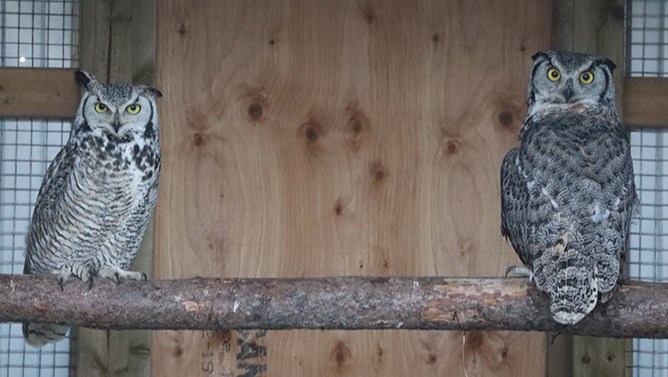CANORA — “It’s bittersweet for us to see them go, but it’s so good to see them healthy enough to be back in the wild again.”
After staying at Majestic Raptor Rehab of Canora for close to a year (since June 8), Clacker, a great horned owl, was released into the wild near Canora on a sunny, pleasant May 27 evening.
Mary Huebert, Majestic Raptor Rehab Owner, said they chose a spot about a 15-minute drive west of Daniels Drive for the release because it has “just about all natural growth, plenty of wildlife, very few people and almost no vehicle traffic.”
“It’s such a lovely area for Clacker to be released,” said Elizabeth Dobb, who had discovered the owl with a broken leg near her home outside of Keeseekoose First Nation. Dobb kept in touch with Huebert throughout the rehabilitation process and was there for the release.
Clacker, named for the clacking sound he makes, had the fracture was set at the University of Saskatchewan small animal clinic, and then was brought in for observation every week during the healing process to make sure the leg was healing properly. Clacker resided at Living Sky Wildlife Rehabilitation in Saskatoon during this time, and didn’t much appreciate having to be off his feet, according to Huebert.
After arriving at Majestic Raptor Rehab in June, Clacker continued to heal and gain strength. One of the final tests to see if raptors (birds of prey) are ready to be released is to see if they will hunt mice.
“They store and hide the mice when they start catching more than they need,” said Huebert, “and that’s a pretty good indicator that they’re ready to be out on their own.”
Majestic Raptor Rehab takes in sick, injured or orphaned raptors and then works with them toward the goal of releasing them back to the wild.
Last Oct. 24 they took in Brittany, another great horned owl found at the Yorkton truck scale after being hit by a vehicle.
Huebert said they decided to keep Clacker and Brittany in the same pen during their rehabilitation. “We found they benefit from having them together, they seem to get along well.”
Hubert reports that Brittany is progressing well and should be ready for release in the not-too-distant future.
There are approximately 25 species of raptors in Saskatchewan, including hawks, eagles, owls and falcons.
At the present time, Majestic Raptor Rehab has a capacity of about 30 raptors. Huebert said they housed a total of 14 birds of prey over the past winter.
“We had seven hawks and seven great horned owls. The owls can each eat up to eight mice per day. Our total feeding costs averaged right around $2,000 per month.”
Hebert said they have recently expanded their facility, and now have five large flight cages, ranging from 54 to 100 feet in length. They keep in touch with the Wildlife Rescue Society of Saskatchewan to receive notification of any raptors in need of rehabilitation.
Huebert urges anyone who finds an injured raptor to bring it in to Majestic Raptor Rehab or give her a call at 306-563-7252.
Don't count on social media to deliver your local news to you. Keep your news a touch away by bookmarking Canora Courier's homepage at this link.
Bookmark SASKTODAY.ca, Saskatchewan's home page, at this link.




